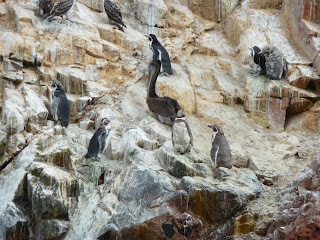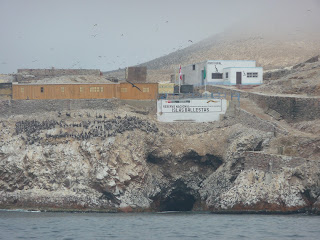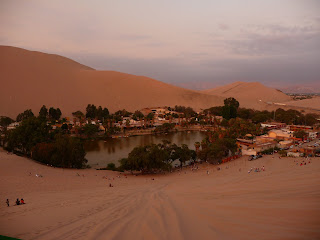En la costa peruana cerca de Lima, hay muchas cosas para hacer. Paracas es el puerto de donde salen las visitas a Islas Ballestas, el lugar que unos libros guías se llaman "el Galápagos de los pobres".
Aunque no pienso que tenga la misma sensación que Galápagos, Islas Ballestas es un lugar que realmente vale la pena para visitar. Hay una enorme cantidad de pájaros (pelícanos, pingüinos, cormoranes, gaviotas, etc.) y con ellos, también viene un olor bastante interesante... La minería del guano ha tenido lugar en las islas desde hace muchas décadas y en algún momento, formó una parte muy importante del ingreso nacional de Perú.
Respecto al mamíferos, hemos visto hordas de lobos del mar. Son focas bastante grandes que vienen a las islas en su época de reproducción y cuando no hacen crías, su pasatiempo favorito es acostarse perezosamente en las rocas.
 |
| ¡Que rodeemos el pelícano! |
 |
| Pájaros, pájaros y más pájaros |
 |
| Un lobo del mar haciendo su pasatiempo favorito |
 |
| Desde aquí viene el guano |
Durante la noche, tenía mi primera experiencia personal de un seísmo. Como ocurrió unos minutos después de medianoche, estábamos durmiendo y en los primeros segundos, pensamos que todavía estamos soñando... Nos asustamos muchísimo y corrimos al patio del hotel y finalmente pasamos la noche por allí abajo de las estrellas en el estilo woodstock. Según las noticias, tenía una magnitud de 6,3 y parece que estábamos justo en el epicentro: http://noticias.aollatino.com/2012/01/30/peru-sismo-costas/
 |
| Buggy en las dunas de Huacachina |
 |
| Las dunas |
 |
| El oasis de Huacachina |
 |
| Nuestro nuevo amigo llegando al restaurante |
 |
| Mañana de Woodstock después del seísmo |
-------------------------------------------------------------------------------------------------------------
On the Peruvian coast close to Lima, there's a lot to do. Paracas is the port from where boats are going to Islas Ballestas, the place to which many guidebooks refer as "the Galápagos of the poor".
Although I don't really believe that it lives up to Galápagos, the Ballestas Islands definitely worth the effort for a visit. There's an enormous amount of birds like pelicans, pinguins, cormorans, seagulls, etc. and with them, a pretty interesting smell is also present... Guano mining has taken place already for long and there was a time when this was one of the main sources of income of Peru at national level.
In terms of mammals, we have seen hordes of sea wolves. They are big seals who are coming to the islands in their period of breeding and when they're not producing their offspring, their favourite activity is to lay lazily on the rocks.
My hostel was in Huacachina, another interesting place in this region. Huacachina is known for its dunes and the main tourist activity here is to go on a buggy ride in the dunes and do some sandboarding. This was a lot of fun and pretty much like a rollercoaster as our driver did several jumps and crazy manouvers between the dunes. It's very unfortunate though that they don't seem to pay much respect for the environment - there was plenty of garbage buried partially in the sand...
During the night, I had my first personal experience of an earthquake. Since it happened just a few minutes after midnight, almost everyone was sleeping by that time and in the first seconds, we thought that we're still dreaming... It was pretty frightening and everyone ran out of the rooms to the courtyard where we finally passed the night in woodstock style. The day after we learnt from the news that it was a 6,3 quake and it seems that we were right in the epicenter of it: http://www.foxnews.com/world/2012/01/30/magnitude-63-earthquake-shakes-peru/?test=latestnews
The next stop will be Arequipa, some 1000 km further to the south, to see the canyons and the mountains.
No comments:
Post a Comment